
Three hour meeting bundles start at $700.
Start on a new journey today.

Three hour meeting bundles start at $700.
Start on a new journey today.
Sign up for our Muse-letter now!
By Ivan Barnett

“Being Curious Is Essential to Having a Great Career,” Santa Fe Window. Image Ivan Barnett
“Kids grow up with innate curiosity. It’s the hardwired instinct that permits us to walk, talk and survive long before we get to school.” — Seth Godin Seth’s Blog
Curiosity gets us moving. In studios, galleries, and museums, as well as life itself, it’s the spark that sends an artist down a new path, a curator into an unfamiliar archive, a director toward a riskier exhibition. But curiosity alone doesn’t ship the painting, open the show, or change a community. That second engine is rigor: the habit of showing up, testing, documenting, and improving.
Seth Godin’s reminder is timely for the arts. His short essay on Rigor and curiosity reframes the false choice between wonder and discipline. We don’t have to pick one. The opportunity, especially in our field, is to braid them. Seth’s Blog
Curiosity in the studio is easy to recognize: a sudden material experiment, an unexpected color harmony, the form that “asks” to be turned upside down. Rigor is what makes that discovery repeatable without sacrificing character.
Godin’s older post, The rigor imperative, says it plainly: “Do the math, do the reading, do the budget. Do it right.” Bring that same sobriety to materials, schedules, pricing, and editioning. Your future self—and your gallerist—will thank you. Seth’s Blog

“Look Up for Options,” Historic Window, Santa Fe. By Ivan Barnett
Curiosity fuels inventive programming: invite contrarian pairings, commission new work, ask “Who’s not in the room?” Rigor is the discipline that turns vision into outcomes.
Rigor doesn’t dull the edge; it preserves it by building systems that keep you daring yet still focused.
Museums are built for rigor—collections management, conservation, peer review. The growth opportunity is to match that rigor with everyday curiosity:
The point isn’t to chase novelty; it’s to create a consistent practice of learning, then codify what you learn.

“Fear Of Failure Is Our Worst Enemy,” Santa Fe Door. Image Ivan Barnett
Artists
Galleries
Museums
Funding resources are tighter, attention is fragmented, and audiences are more diverse and more discerning than ever. Curiosity ensures we keep asking better questions about our work ensuring we keep our promises: to artists, to visitors, to communities, to donors.
Godin’s line about the blend is the lever: curious people may need some rigor, and rigorous people always need more curiosity. It’s a mutual enhancement: disciplined creatives who remain open, and organized institutions that never stop learning. Seth’s Blog

“Seeing Clearly Takes Much Practice,” Santa Fe Window, No 1. Image Ivan Barnett
The arts don’t need more noise; they need more focus and disciplined practice. Curiosity to find the thread. Rigor to weave it into something an audience can enter, explore, and remember.
If you’re an artist who needs cadence and clarity, a gallery that wants braver programming without the chaos, or a museum ready to prototype and learn faster, Serious Play can help. Reply to this note or visit serious-play.co to schedule a short intro call. We’ll ask three questions: What decision do you need this to change? What’s the smallest test? How will we know it worked?
“If you are lucky enough to find a curious person, perhaps they could benefit from a little rigor.” — Seth Godin Seth’s Blog
© 2025